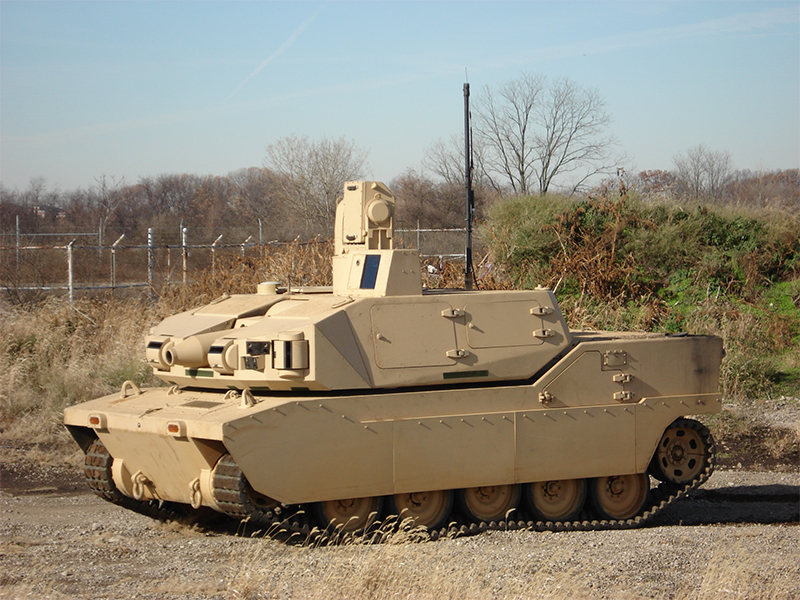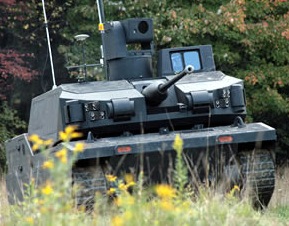BAE Systems Black Knight Tank – Unmanned Combat Vehicle
Generals have always sought to accomplish their objectives while losing as few men as possible. With the advent of unmanned aerial aircraft, the common soldier is now given an unprecedented eagle’s eye view of the battle space. Therefore, commanders use a linked network of unmanned drones to communicate with individual units, locate the enemy, and even launch attacks. But even with absolute control of the airspace, there still needs to be a ground presence.
Enter: BAE Systems Black Knight Tank.

Black Knight Tank Capablities
In a 2007 presentation put on by BAE, a Black Knight tank proved its viability as a reconnaissance vehicle. It was able to maneuver to a position of cover and observe battle damage while a manned Bradley Fighting Vehicle’s crew lay down kinetic fire on a simulated target. Furthermore, the Black Knight tank was successfully able to maneuver and report back to the manned vehicle on its effect on target. This is invaluable information for a tank crew and it doesn’t require them or another crew to move into a vulnerable position.

The United States Army has employed armed drones and unmanned vehicles in multiple capacities over the years. The US intends to keep a remote human always behind the trigger. Because of this, at every stage in development, the ultimate choice to pull the trigger on releasing ordnance has always come from a human pilot.
Sensors
The Black Knight is able to provide pivotal ground intelligence for other armor & dismounted personnel in the area. Its sensors can observe the enemy from a closer range than a manned crew could approach without getting in harm’s way. The new generation of unmanned fighting vehicles are prepared to assist manned crews on the battlefield. However, they also can be commanded to fire upon targets to protect the rest of the team.
“If the enemy target needed to be re-engaged, the Black Knight could effectively neutralize the target, but the command to fire would always be made by a remote Soldier and only after the data necessary to make positive identification is received,” explains BAE.

Armament
Initially tested in 2007, the Black Knight Tank is a 9.5 ton autonomous vehicle based off the same basic frame as the Bradley Fighting Vehicle. Additionally, its base armament includes a 25mm gun and a coaxial machine gun that can be controlled remotely. The vehicle itself has limited autonomous control.
Evaluation
Before anyone gets too excited, this Black Knight won’t be available on the battlefield for quite some time. It is still undergoing an extensive testing phase by the U.S. Army before it sees actual deployment. However, that hasn’t stopped BAE from creating one of the world’s most impressive unmanned fighting vehicles. It’ll be necessary as countries like China develop their own unmanned armored tanks to compete in the battlefield.
Black Knight Vs The Chinese ZSD-63 Autonomous UGV
The Chinese ZSD-63 is an armor platform that has existed in the Chinese arsenal since the 1960s. It can be equipped for more active combat roles like mortar and gunnery or serve as command and control or troop transport. The big difference between the unmanned version of the ZSD-63 and the ZSD-63 Autonomous UGV is the sensor array located by the crew hatches. The sensors include three LIDAR, radar, and video camera stations mounted on the front of the ZSD-63. These features give the ZSD-63 a complex, informed view of the battlespace that the naked eye simply would not get. It is an impressive, aged vehicle that was recently engineered to drive autonomously.
The Black Knight’s sensory kit is outfitted with Laser Radar (LADAR), thermal imaging camera high sensitivity video cameras, and GPS. The Black Knight also employs advanced engineering for autonomous mobility. The tank maneuvers and plans routes without the pilot’s intervention. Black Knight’s autonomous navigation system detects and avoids obstacles and comes equipped with day and night operation capability.
Maneuverability
The Black Knight Tank comes equipped with a Caterpillar diesel engine capable of up to 300 hp and a maximum speed of 41 mph. It, like the ZSD Autonomous UGV, relies on mechanical and electrical parts from its predecessor. This makes the Black Knight Tank easy to repair and even easier to get back out onto the battlefield. After all, when the mission entails enemy fire, we’d all rather the unmanned vehicle take the brunt of the damage.

